West Derby, Lancashire
Up to 1834
West Derby had a parish workhouse from 1731 (Hitchcock, 1985). It stood at the north side of Low Hill, near the present-day telecom offices (former Coach and Horses pub).
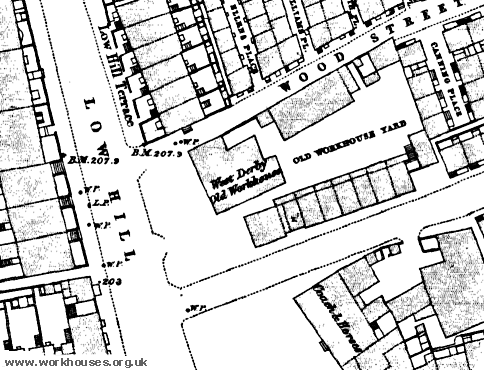
West Derby Low Hill site, 1849.
A parliamentary report of 1777 recorded parish workhouses in operation at Allerton (for up to 50 inmates), Childwall (60), and Wavertree (50) — the West Derby workhouse was absent from this survey.
After 1834
The West Derby Poor Law Union formally came into being on 31st January 1837. Its operation was overseen by an elected Board of Guardians, 31 in number, representing its 23 constituent parishes as listed below (figures in brackets indicate numbers of Guardians if more than one):
County of Lancaster:
Aintree, Allerton, Bootle-cum-Linacre, Childwall, Great Crosby, Little Crosby, Croxteth Park, Everton (2), Fazakerley, Garston, Ince Blundell, Kirkby, Kirkdale (2), Litherland, Lunt, Netherton, Orrell and Ford,
Sefton, Thornton, Toxteth Park (5), Walton on the Hill, Wavertree, West Derby (3).
Later Additions (from 1894): Seaforth , Waterloo.
The population falling within the Union at the 1831 census had been 53,058 with parishes ranging in size from Croxteth Park (population 42) to Toxteth Park (24,067).
West Derby was a large union which surrounded the city of Liverpool. In 1857, its population had increased to the point where its poor relief was becoming difficult to manage and the parish of Toxteth Park separated from the union to operate as an independent Poor Law parish. The West Derby Union operated an unusually large number of poor-law institutions which are described below.
In 1922, the adjacent Toxteth Park Union and the Liverpool Poor Law Parish were dissolved and their catchment area and institutions coming under the jurisdiction of the West Derby Union.
Mill Road Workhouse and Hospital
Initially, the West Derby union continued using the old Low Hill workhouse. The union erected a new workhouse on Mill Road in 1838-40, with the first inmates moving in in 1841. Almost immediately, the old building was rented to the Liverpool parish authorities to relive the overcrowding in their Brownlow Hill workhouse.
The Mill Road workhouse adopted the typical cruciform plan of the period.
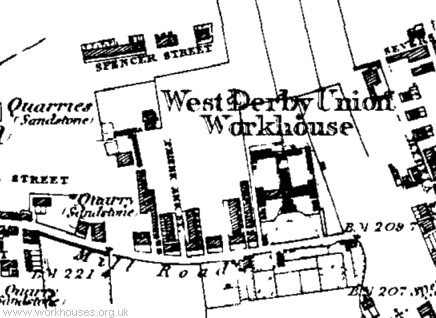
Mill Road infirmary site, 1906.
On March 21st 1843, a fire at the workhouse destroyed a large quantity of clothes and bedding.
In November 1866, the workhouse was visited by Poor Law Board Inspector Mr RB Cane. His report noted:
At the present time there are 427 cases on the medical list. There is no resident medical officer, but two medical officers constantly attend. There are 15 resident nurses, with salaries varying from 15l. to 30l. a year, with rations, &c., for each. Four of these nurses act as "night nurses". The Guardians provide all drugs, &c., at a cost of about 400l. a year. They have also appointed a "dispenser," who is in attendance during the whole of each day.
The site was rebuilt in 1891-93 for use as an infirmary. The infirmary's architect was Charles H Lancaster who also designed the Union's buildings at Fazakerley and Alder Hey. The location and layout of the Mill Road infirmary is shown on the 1906 map below:
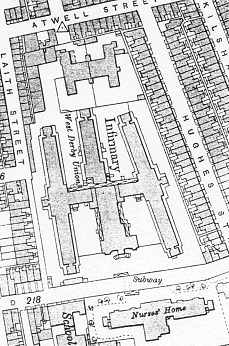
Mill Road infirmary site, 1906.
The new building comprised an administrative block and five hospital blocks. It had 690 beds with a separate 150-bed mental department. A nurses' home stood at the south side of Mill Road.
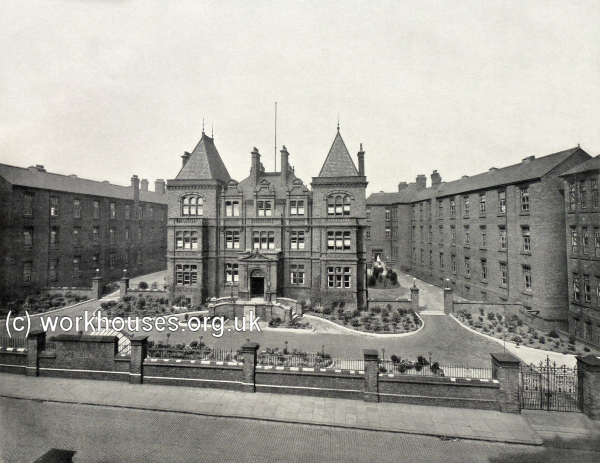
Mill Road infirmary from the south.
© Peter Higginbotham.
In 1894, the British Medical Journal set up a "commission" to investigate conditions in provincial workhouses and their infirmaries. Following a visit to newly constructed Mill Road Infirmary, the commission's report recorded a "most favourable impression" praising both the buildings and the medical care. It was noted that paupers took no part in the nursing. The staff included a medical superintendent, a trained matron with two assistants, a staff of more than sixty nurses, some of whom have been trained in the infirmary, and a night superintendent. Further details are available in the full report.
The establishment later became Mill Road Maternity Hospital The buildings have been demolished and housing now occupies the site.
Walton-on-the-Hill
In 1864-9, a new workhouse was built on Rice Lane at Walton-on-the-Hill to serve the northern part of the Union. It was designed by William Culshaw who was also the architect of the nearby Toxteth Park workhouse. The Walton workhouse initially accommodated 1,200 inmates and its construction cost £65,000. It gradually expanded and by 1930 could hold up to 2,500. Its location and layout are shown on the 1906 map below:
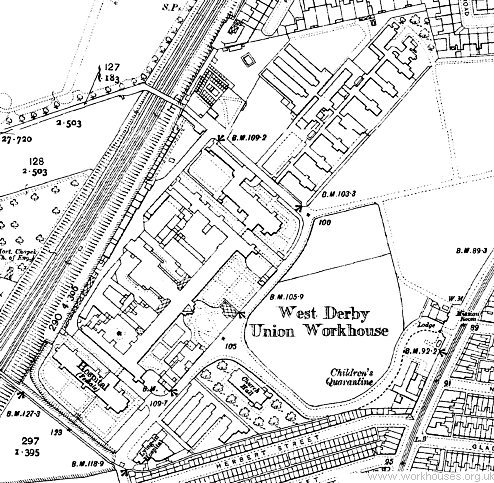
West Derby Walton map, 1906.
FOR WEST DERBY UNION, LIVERPOOL.
THE new workhouse at Walton, the first stone of which was laid on the 29th of March, 1864, by Mr. Thomas Haigh (the then chairman of the West Derby Board of Guardians), has been formally opened. The edifice has been constructed to accommodate 1,000 inmates, and has cost, including the price of the land (purchased from Lord Sefton), 65,000l. The grounds extend over an area of 37 acres, and it is intended to devote a great portion of the land to cultivation, so as to afford useful employment for the inmates. At either end of the building are hospitals for male and female inmates, and it is intended immediately to proceed with the laying out of a cemetery and the erection of a church. The main building is already nearly full ; and it is probable that in course of time the accommodation will not be too much for the numerous poor chargeable to the rates of the West Derby Union. Messrs. Culshaw & Sumners are the architects, and Mr. James Walters, the builder.
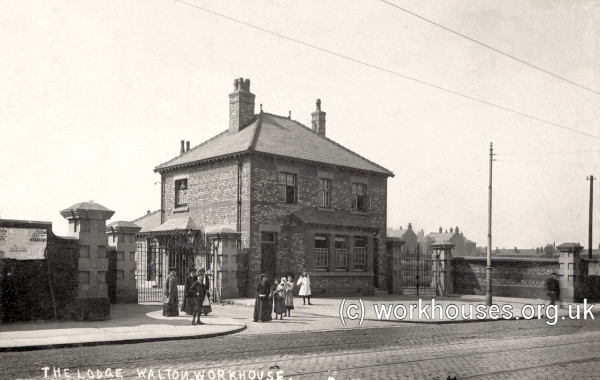
Walton workhouse entrance lodge from the south, c.1905.
© Peter Higginbotham.
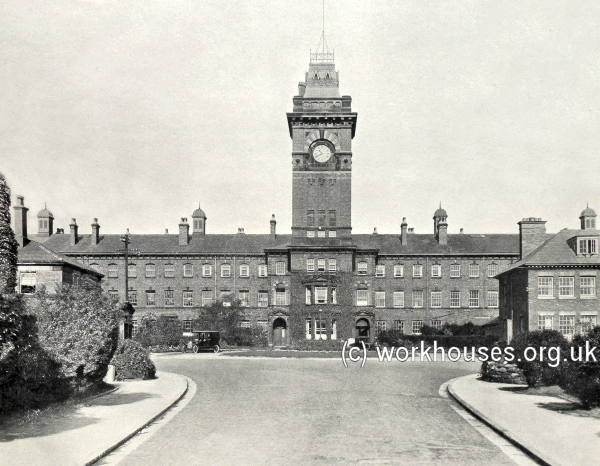
Walton workhouse main block from the south-east, c.1925.
© Peter Higginbotham.
The main building was a long three-storey T-shaped block, with males accommodated at the east and females at the west.
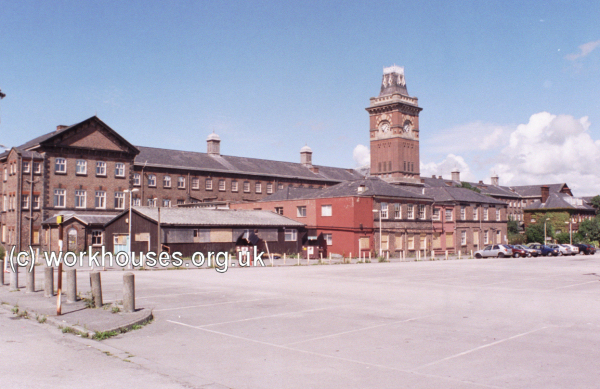
Walton main block from the south, 2001.
© Peter Higginbotham.
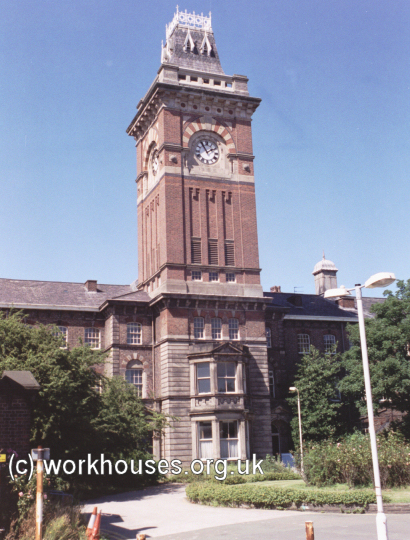
Walton main block entrance from the south-east, 2001.
© Peter Higginbotham.
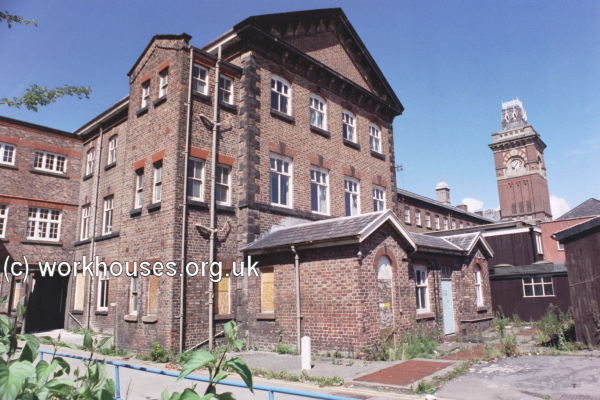
Walton main block from south-west, 2001.
© Peter Higginbotham.
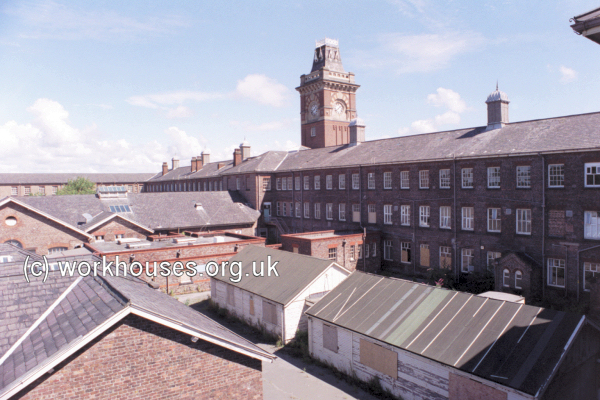
Walton rear of main block from the south-west, 2001.
© Peter Higginbotham.
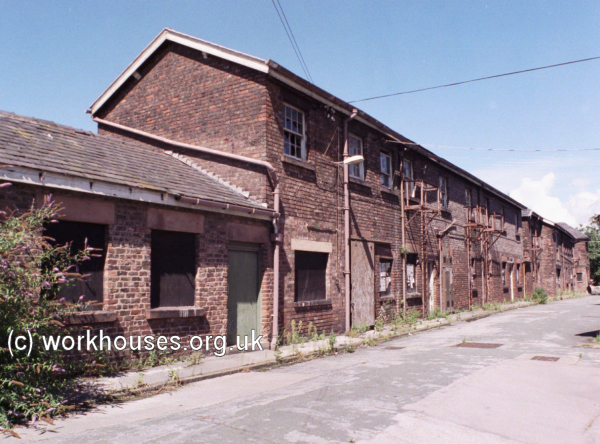
Walton men's workshops from the south-west, 2001.
© Peter Higginbotham.
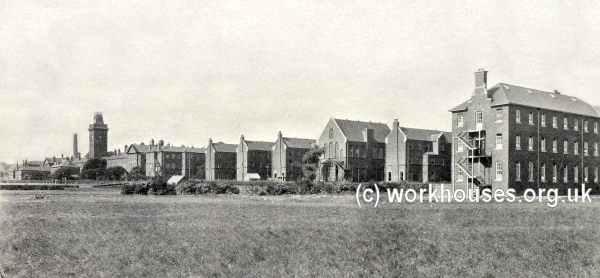
Walton workhouse infirmary blocks from the east, c.1925.
© Peter Higginbotham.
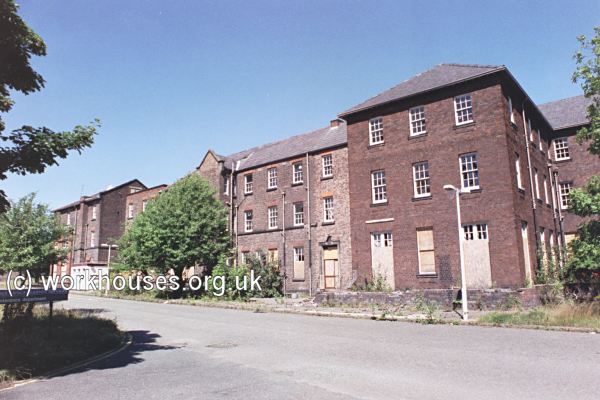
Walton male infirmary(?) block from the south, 2001.
© Peter Higginbotham.
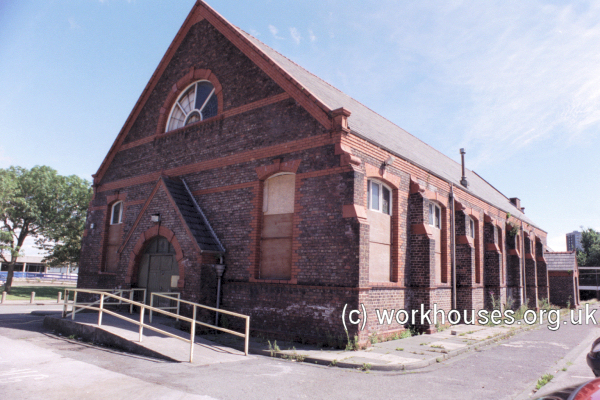
Walton chapel from the north-west, 2001.
© Peter Higginbotham.
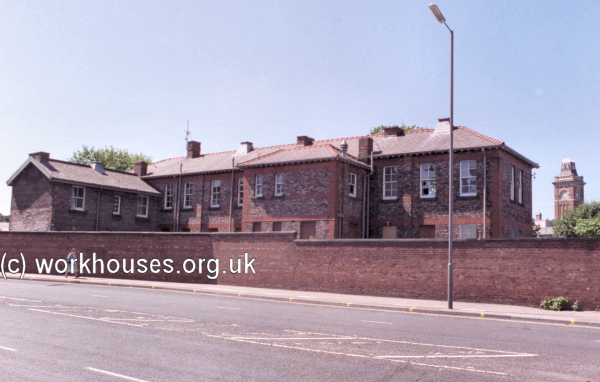
Walton children's quarantine block from the east, 2001.
© Peter Higginbotham.
According to the 1900 Gore's Directory of Liverpool and Birkenhead, new schools "erected on the cottage principle" and costing £20,000 were opened at Walton Workhouse on December 9th, 1879.
The workhouse later became Walton Institution and then Walton Hospital until its closure in the late 1990s.
Belmont Road Workhouse
In 1889-90, a "test" workhouse was built on an 18-acre site at Belmont Road. It catered primarily for able-bodied men and women, many of whom were vagrants, providing daily out-relief in return for manual labour. Its location and layout are shown on the 1906 map below:
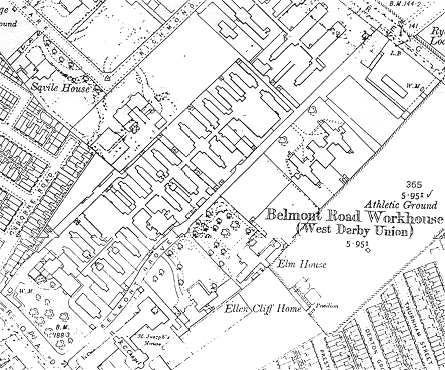
Belmont Road workhouse site c.1906.
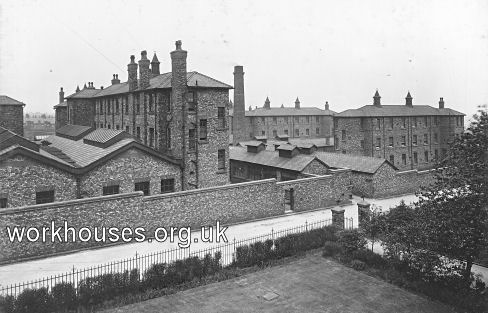
Belmont Road workhouse casual wards c.1925
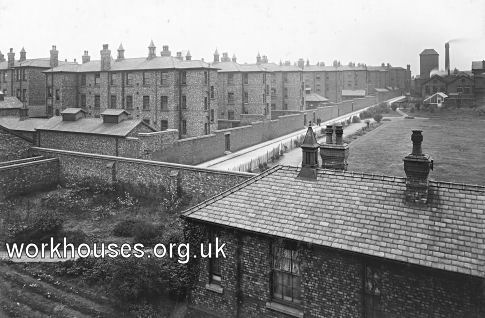
Belmont Road workhouse c.1925
As noted above, a British Medical Journal commission visited West Derby in 1895 and inspected the Belmont Road premises. The commission noted that the workhouse had separate infirmaries for vagrants and for other inmates. The vagrants' infirmary had 35 beds for women, and 44 for men, with venereal cases placed separately on the top floor at each side. Acute cases included skin eruptions, cases of syphilis, and patients who had been exposed to chill or severe weather. The infirmary for other inmates had 36 beds for women and 42 for men. The sick cases included one of pneumonia following influenza, a man convalescent from bronchitis, another with chronic bronchitis, and one crippled with rheumatism. Among the women were several cases of old age and infirmity, which prevented them going up and down stairs. In the downstairs day-rooms most of the women were at needlework; a few of the men were playing a game, but the larger number were in a listless group round the fire. Further details are available in the full report.
The picture below, which dates from around 1920, was kindly contributed by John Hobson. It shows a group of workhouse staff at the Belmont workhouse, the lady on the left thought to be John's great aunt Blanche Rosa Ashbury who held the post of sewing mistress.
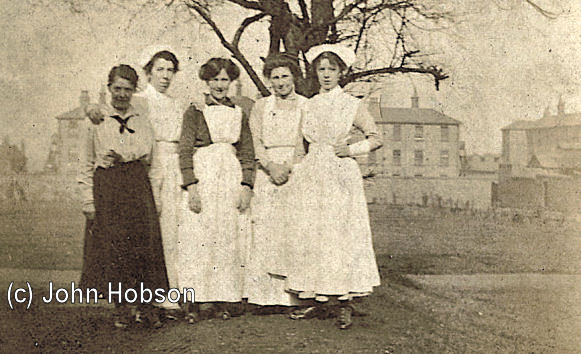
Belmont Road workhouse c.1920.
© John Hobson.
The Belmont Road workhouse later became Newsham General Hospital. Virtually all the buildings have now been demolished.
Fazakerley Cottage Homes
Cottage homes for the accommodation of pauper children were erected at Fazakerley in 1888-9 to designs by CH Lancaster. They homes could accommodate a total of 650 children.
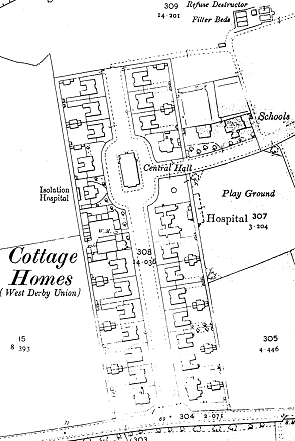
Fazakerley Homes site, 1906.
The entrance to the site was through a gated entrance at the south, flanked by a large arch.
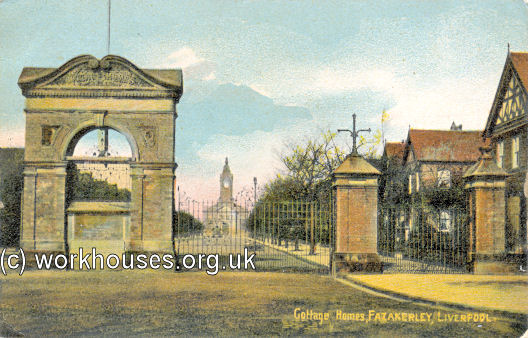
Fazakerley Homes entrance, c.1906.
© Peter Higginbotham.
At the heart of the site was a large central hall used as a chapel and school room.
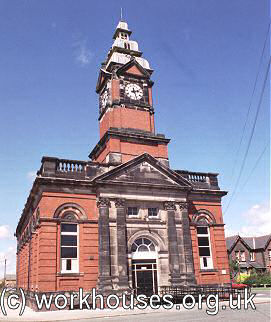
Fazakerley central hall from the south, 2001.
© Peter Higginbotham.
Children were accommodated in houses each of which housed around twenty-five, supervised by a house-father or house-mother.
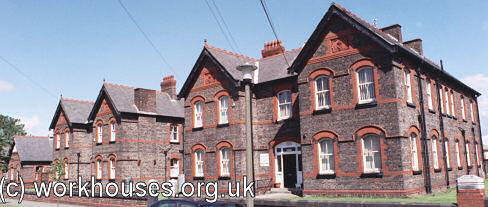
Fazakerley cottage homes from the south-west, 2001.
© Peter Higginbotham.
The site also included an entrance lodge, receiving home, infirmary, workshops, and swimming baths.
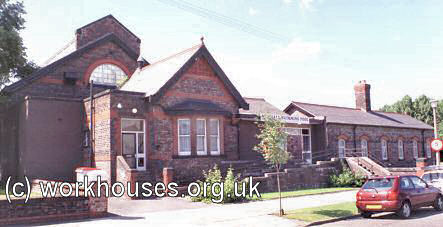
Fazakerley swimming-baths and workshops from the south-east, 2001.
© Peter Higginbotham.
In 1965, the site became a home for children with learning difficulties. It is used by social services to provide day centre and training facilities.
Alder Hey Hospital
On 3rd March 1911, Mr JS Davy laid the foundation stone for a large new hospital at the west side of Eaton Road at Alder Hey. Completed in 1915, it provided accommodation for 1,000 chronic and bed-ridden patients.
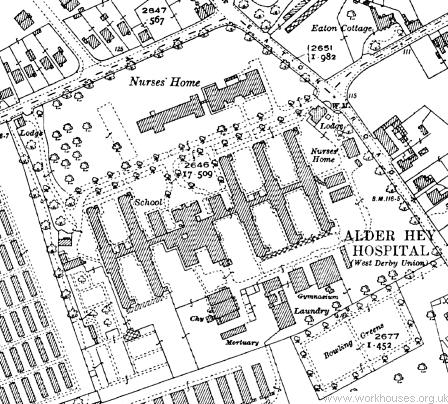
Alder Hey Hospital site, 1927.
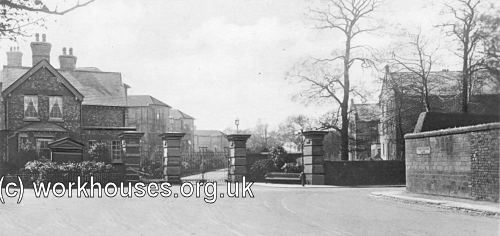
Alder Hey Hospital entrance from the north-east, date unknown.
During the First World War, Alder Hey was used as a military hospital. After the war, its role changed into that of a dedicated children's hospital.
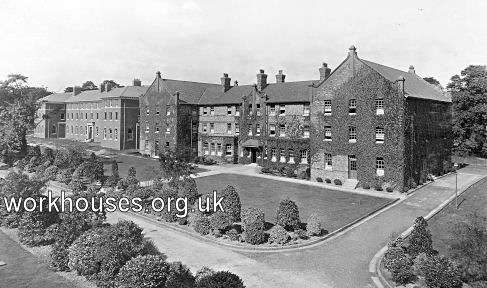
Alder Hey Hospital Nurses' Homes, c.1925.
During the Second World War, part of the hospital was again used for the reception of military casualties.
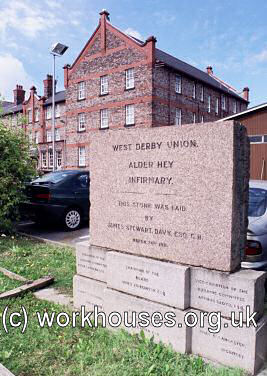
Alder Hey Hospital, 2001.
© Peter Higginbotham.
Alder Hey is now one of the country's major hospitals specialising in the care of children.
Seafield House
In around 1914, the West Derby Union converted and extended a former convent on Waterloo Road at Seaforth to provide accommodation for 'mental defectives'. The inmates of the institution, known as Seafield House, were mainly children. At the outbreak of World War 2 in 1939, all the children were evacuated to Greaves Hall Hospital, Southport.
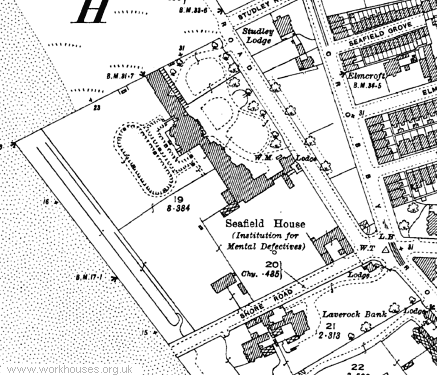
Seafield House site, 1927.
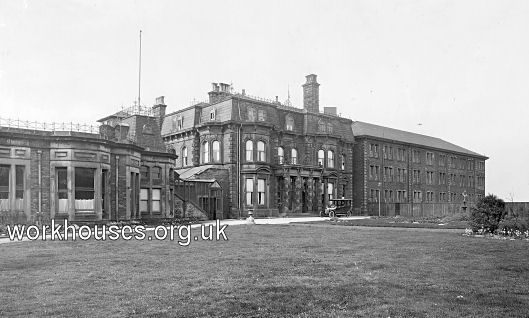
Seafield House from the east, c.1925.
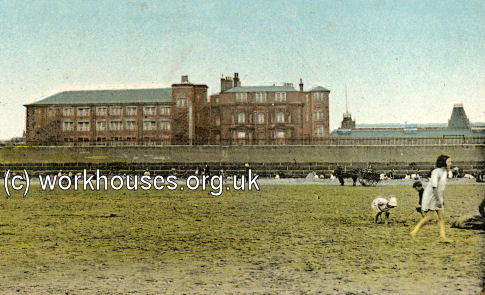
Seafield House from the south-west, 1930s.
Deysbrook House
Deysbrook House, on Deysbrook Lane in West Derby, was a convalescent home for children.
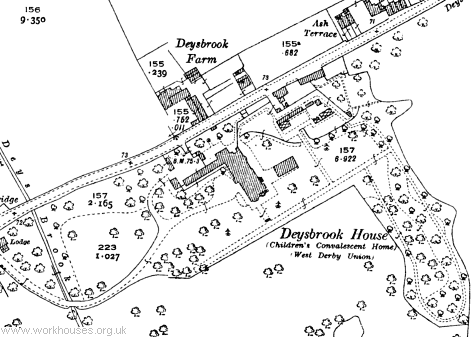
Deysbrook House site, 1927.
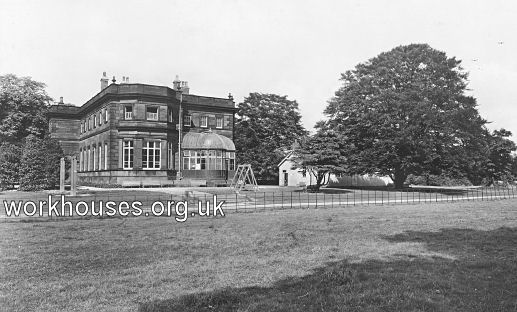
Deysbrook House from the south, c.1925.
Union Offices and Relief Offices
The West Derby Union had its main offices on Brougham Terrace at the west end of Boaler Street. The union also operated a number of out-relief offices including ones at: 225 Stanley Road; Green Lane; 11 Mount Pleasant, Waterloo; 2 St John's Road, Bootle; Garston; Wavertree; 145 City Road, Walton; and Marsden Street, Toxteth Park.
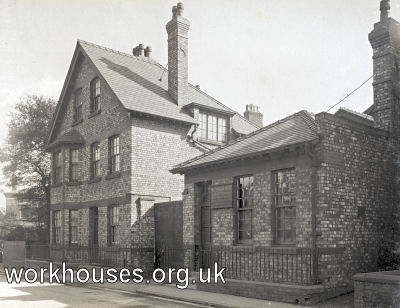
A West Derby Relief Office, c.1925.
Other Establishments
In 1914, the union took over the Working Boys' Homes 101 and 103 Shaw Street which had previously operated as the Wesleyan Mission Boys' Homes. It then became known simply as the 'Boys' Home' in c.1948. The union also administered a Domestic Training Home for Girls at 57 Shaw Street.
Staff
Inmates
Records
Note: many repositories impose a closure period of up to 100 years for records identifying individuals. Before travelling a long distance, always check that the records you want to consult will be available.
-
Liverpool Record Office and Local History Service, Central Library, William Brown Street, Liverpool L3 8EW.
Holdings include: Guardians' minutes (1848-1930).
- Mill Road — limited holdings include: Creed Register (1870-1939).
- Walton workhouse — only a few miscellaneous records survive (1866-1935).
- Belmont Road (Newsham Hospital) — holdings include: Admission and discharge registers (1924-1970); Birth and death registers (1909-1988).
- Fazakerley Homes.
- Alder Hey — no early records survive.
- Seafield House (Greaves Hall Hospital) — various records (1914-75).
- Shaw Street Boys' Home — Admission and Discharges (1934-51)
Bibliography
- Hitchcock, T.V. (1985) The English workhouse: a study in institutional poor relief in selected counties. l695-l750. (DPhil thesis. University of Oxford.)
Links
Unless otherwise indicated, this page () is copyright Peter Higginbotham. Contents may not be reproduced without permission.


